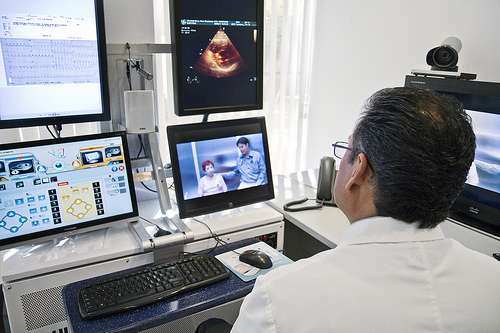Health and medical advice from your hip pocket

Western Australia is one of the most remote areas in the world, this presents a range of challenges when delivering health services to those not within an easily commutable distance of Perth.
WA hospitals often have trouble getting enough medical specialists in the city, so getting services to rural and remote areas can be extremely challenging.
Telehealth—that is, creating interactions between health providers and patients using technology, rather than face-to-face—seems an obvious solution to this.
The idea is not new, and the history of telemedicine in Australia stretches back to 1874, where doctors would use the telegraph to give instructions to people injured in remote areas.
Telehealth technology has moved on markedly since then, and most health and medical specialities now have access to a range of equipment and procedures that can facilitate diagnosis, treatment or consultation via telehealth.
Some are simple, such as Skype consultations, whilst others involve sophisticated technology that can remotely diagnose cancer, eye disorders or ear disease.
Yet, despite these advances, the access to and uptake of telehealth services in many areas is less than expected, or is limited to a narrow range of specialities or procedures.
There are some key barriers to accessing telehealth services, and they involve telehealth innovators and researchers, policymakers and clinicians.
For instance, clinicians and policy makers have argued that whilst much is written about the benefits of telehealth, there is often a lack of evidence-based research on telehealth interventions and their comparability to current services.
They also lament the lack of prescriptive guidance in how to design and implement a telehealth program for a specific speciality or procedure, and continued training in its usage.
Without this, it makes it difficult for clinicians to confidently use the technology, and hard for health services to assess the effectiveness, and therefore harder for policy makers to justify to fund projects.
Funding and internet availability key to success
The obstacles faced by telehealth implementers and researchers include a lack of basic infrastructure to support telehealth services, such as a high speed broadband internet connection, and a lack of funding to support start-up services, training programs and "store-and-forward" telehealth programs which are used to collect and transfer images or test results for remote interpretation by specialists.
Government imposed 'minimum distance requirements'—which require patients to live a certain distance from a hospital before a telehealth service can be established—are another barrier to telehealth services, as it prevents universal telehealth provision that could improve efficiency in city hospitals as well as enable access to services in rural areas.
But there are also opportunities—the ubiquitous use of smartphones—and the healthcare apps they can support, offer huge potential in telehealth service delivery.
Patient acceptance was also originally thought to be a considerable barrier to telehealth.
However, research has shown most patients are just as satisfied with receiving services via telehealth.
It saves them time and money through reduced travel, the consultation time is equivalent, and the patient outcomes are comparable to face to face treatment.
Whilst there are potentially huge financial savings to be made in telehealth, there are a number of barriers faced by telehealth providers and clinicians that can make services difficult to implement or inefficient.
Telehealth is an amazing resource that has potential to engage with patients and provide huge benefits for people in rural and remote communities, and is a great way to save money in health systems.
However, greater synergy between telehealth researchers, clinicians and policy makers has the potential to improve the quality and the number of services offered in WA.















